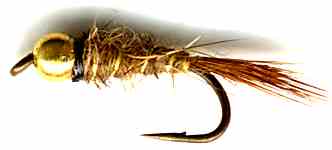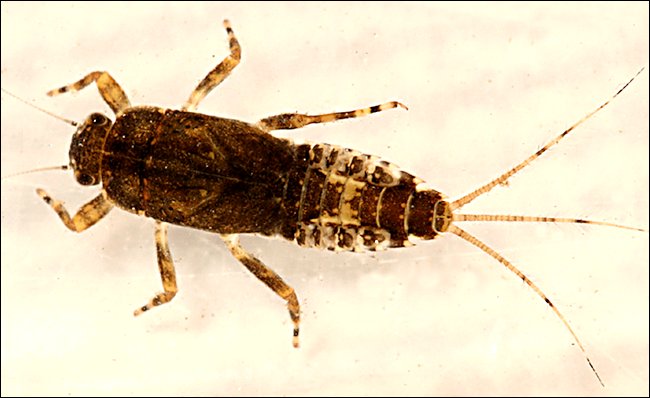Brown Beaded Gold Ribbed Hare's Ear Nymph
Pale Morning Dun mayfly nymphs can be imitated with a brown Gold Ribbed Hare's Ear nymph fly pattern. They are great trout catching flies. The aquatic insect crawls around in the bottom debris and rocks in flats, runs and riffles of rivers with moderate currents.

BEADED GOLD RIBBED HARE'S EAR FLY PATTERNS. Hook size 10 12 14 16 18 20 - $US each
It is in their nature to hide as they know they are on most hungry fish food menus. The nymph size ranges from 7-9mm (1/3 to 3/8 inch long). They have three tails, long oval shaped bodies that are normally olive-brown in colour. When small they are normally only available to trout to snack upon if there has been some kind of disturbance that has dislodged them from their normal hiding place.
As the PMD mayfly nymph matures the wing pads on their back grow bigger and darken. As the date of their emergence gets nearer they become more active. They often migrate to areas of the river with slower water currents. They are poor swimmers so they utilize fast currents to move to different calmer locations. This makes them susceptible to predation. Although trout can find some PMD nymphs drifting in the currents before the hatch, it is during the emergence that they become a major food source. This is when they are most vulnerable. Just before the hatch they slowly swim to the surface, where they hang below the surface film for a period of time before the dun emerges. It is the water temperature that dictates how long the nymph drifts before it starts to emerge into an adult PMD dun. It is harder for the nymph to break through the water surface film in cold weather calm water conditions.

Trout will take up feeding positions just before the hatch starts. They will look for a good location that has a steady supply of PMD nymph drifting past on their way upwards towards the surface. This is especially true on waters that have a lot of fishing pressure or broken water. They will concentrate of nymphs moving past them than spend time looking for emerging mayflies on the surface
The best way to match the hatch is to catch a few nymphs in a small long handled fishing net. Then you can examine them, note their size and color. You can use a child's fishing net on a bamboo pole or go and visit your local tropical fish center and buy one of their fine weave nets for small fish species. Make sure the net is bright white to help with your examination
How to fish deep with a Beaded Brown Gold Ribbed Hare's Ear Nymph
Use the deep water nymphing technique when fishing riffles and runs before a hatch. The same goes for fishing pocket water during a hatch when the trout are not rising. This method of underwater fishing gets your fly pattern down fast, to the level where the trout are feeding. What you need to do is place an indicator on your leader. If you believe the fish are feeding at a depth of five feet then you want to put the indicator 5 feet up the leader away from the point fly. I always add a few inches to account for drag. Then add a split shot 8 inches up from the fly. If you are finding that the shot keeps slipping downwards then I just tie a barrel knot 8 inches up from the fly and add the shot just above the knot. The number and size of shot will depend on the water flow strength, weight of your fly and depth. I always start out light and then add weight and adjust the level of the indicator until I start getting takes or feel the fly is touching the river or lake bottom.
If a natural mayfly nymph, like a Pale Morning Dun nymph, loses its grip on the bottom and is cast into the current, it will drift close to the bottom for a while before deciding to swim to a different calmer location or sink to the river or lake bed. You have to fish your gold ribbed hare’s ear nymph drag free if you want to successfully imitate the natural mayfly insect that is suspended in the current. You will have to use your rod to control the drifting line in the water to make the line is not tight.
Cast quartering upstream to the desired drift line. At the end of the forward cast I lower my rod tip and point at indicator. I follow the indicator's progress downstream with my rod tip. When I notice too much slack is developing in the fly line that is when I lift the rod while continuing to follow the indicators movement. On longer casts you have to strip in excess line. Remember a little slack in the line is necessary to prevent dragging. You will scare away the lurking trout is they see their next meal doing something strange. Mayfly nymphs do not normally stay still in the middle of the current and make a disturbance in the water. They float and go with the flow. That is what you want your GRHE fly to do as well. If the line between your rod tip and the indictor becomes straight the fly will not drift in the current drag free.
In situations where the indicator is directly cross-stream from me, I will rise the rod and lift the fly line off the water, all the way out to the indicator. I then move my rod upstream and lower it to the surface, placing the fly line back on the water upstream from its previous position. I try to do this action in one smooth continuous motion. A mend like this is sometimes necessary to keep the fly line drifting drag free. I will keep following the indicator downstream with my rod again while maintaining a small amount of slack in the line. I let the fly swim to the surface at the end of the drift. I then cast to the next quarter of the river to explore that region of the river or lake bed.
When fishing large riffles or runs I try to start in close to the area I last fished. This way I ensure I cover all the possible hiding places trout maybe lurking in. You must keep your eye on the indicator at all times. At the first sign of unnatural movement during a drift I set the hook by quickly lifting the rod.
CUSTOMER'S COMMENT
This is an aside, but for me a fascinating revelation: I read many years ago that when the time comes for the female mayfly to oviposit she flies upstream, taking wind strength and direction, current speed, river depth - everything! - into account then drops her eggs on the surface so that as they descend through the water column they come to rest at the spot on the river bed where the mother had spent her early life. All this from a 'brain' the size of a piece of dust! More to the point in hand, I shall soon be nymphing in Hokkaido, Japan. There, they often stand directly upstream of a likely riffle and drift the nymph down, under an indicator. They reason that the very broken surface affords them all the camouflage they need, and that their gentle foot steps release tit-bits from the bed and get the fish interested! Maybe worth a try if you're struggling. - Gregor McGregor HK


Fly Fishing books

